Editor’s Note: This is part of a series highlighting economic development in various cities and regions.
The Lilac City is abloom, economically speaking, and city leaders say there's no slowdown in sight.
Rochester, the state’s third fastest-growing city by population, according to a 2016 U.S. Census Bureau report, now boasts eight industrial and business parks, two new malls, a reinvigorated downtown and a five-star rated hospital.
But every city has its challenges. Rochester took a hit last year when the Rochester Fair failed to open for the first time in its 143-year history because of economic woes, though it is expected to reopen in 2018 under new leadership. “It’s a very exciting time to be working here,” says city Economic Development Manager Karen Pollard, who has witnessed many changes in her 14 years on the job. “My first week here, I had an SBA auction of a building. Main Street was very quiet, and it’s certainly not that way anymore.”
With major private and public investments, creative financing arrangements for new businesses, education-business partnerships and the participation of untold numbers of volunteers, the city is on an ascendant curve, though not without challenges.
A Growing City
The lumber, textile and shoe mills, once powered by the Cocheco River in Rochester’s early years, have been replaced by a range of industry from high-tech to composite producers. That growth was aided by the 2013-to-2015 expansion of the Spaulding Turnpike, which provides six exits into the city. The NH Northcoast rail line and Skyhaven Airport also service Rochester.
In 2016, the volume of industrial-commercial property in the city climbed to a record high of 22.5 percent, representing nearly $600 million in value, according to Pollard’s 2017 “State of the City” report. That’s grown 74.6 percent since 2001. Figures for 2017 are not out, but Pollard says the city's goal is to reach 30 percent industrial-commercial base.
One business park alone, Granite State, expanded to 400 acres in 2016, reaching an estimated value of $41.4 million, an increase of 808 percent in 13 years. The Ten Rod Road Industrial Park was the economic hub of Rochester when it housed top employer Cabletron in the 1980s and 90s.
When the Cabletron era ended, it was a huge setback. But once again, the park teems with activity as it is home to Eastern Propane & Oil, Laars Heating Systems, Ashland Electric Products, Granite State College and the Strafford County YMCA.
The Granite Ridge Development District has an estimated value of $74.1 million, a 163 percent increase in 21 years. The Ridge Marketplace, developed by Waterstone, opened to fanfare in 2016 and now includes a Market Basket, Petco and other shops, as well as the 110 Grill. The Ridge is 75 percent complete, and there’s a second phase of development planned.

An aerial view of The Ridge Marketplace, developed by Waterstone, when it opened in 2016. Courtesy of Waterstone Development.
Much of this development was helped by the city’s adoption of TIFs, or tax increment financing districts, which make it possible to invest in new infrastructure upfront, paid for from taxes collected on the increased property value that results. TIFs are authorized under state law. “TIF districts are partnerships,” explains James Grant, director of building, zoning and licensing services for the city. “People wouldn’t be building if the city didn’t do things like this.”
In 2010, the city scored a huge win when it worked with state officials and the NH Community College System to woo Albany International to relocate its headquarters from Albany, NY, to Rochester. The company built a manufacturing plant at Granite State Business Park by Skyhaven Airport and hired hundreds of workers.
The city’s 100-bed Frisbie Memorial Hospital has also experienced growth and won accolades. Early this year, the Centers for Medicare and Medicaid Services gave the hospital its highest overall rating, five stars, for its quality measures, making it one of only three of the 26 acute care hospitals in the state to achieve that ranking. In 2016, the hospital opened its Community Recovery Center to offer help for those with drug or alcohol addictions and launched a mobile integrated health care program to help reduce complications among patients post-discharge.
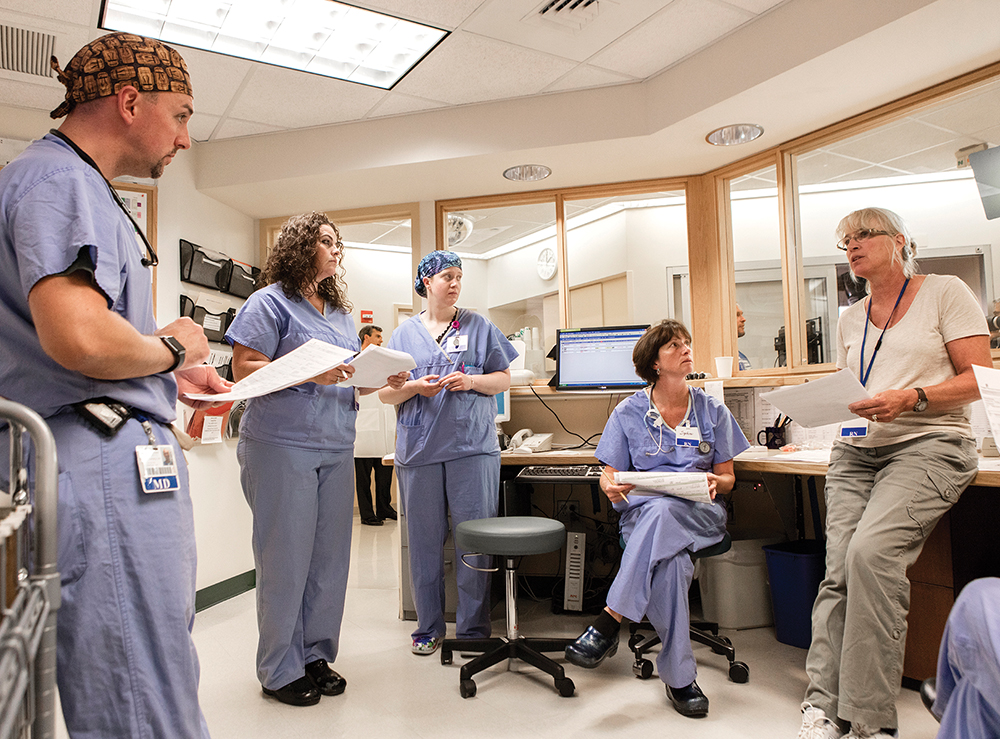 A surgical team at Frisbie Memorial Hospital. Courtesy photo.
A surgical team at Frisbie Memorial Hospital. Courtesy photo.
Resurrecting Downtown
The downtown, now in its 10th year as part of the national Main Street program, has some 225 businesses operating there. While some vacancies remain, the downtown has a ground floor occupancy rate of 84.8 percent, according to Pollard, who can remember when the number of downtown businesses fell below 200 during the recession. In 2016 alone, more than $1.2 million in private investment was poured into downtown, including building renovations and aesthetic improvements, such as commissioning artist James Chase to paint murals throughout the downtown, according to Angela Mills, the new executive director of Rochester Main Street. A new performing arts center also opened in a rehabilitated building on North Main Street.
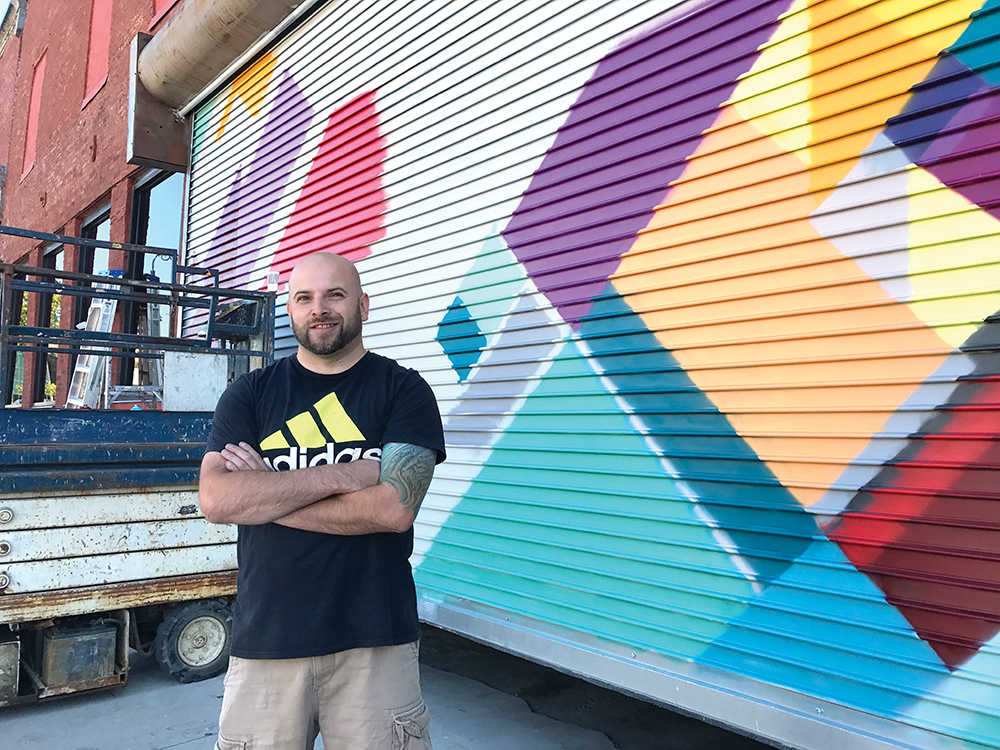
Artist James Chase with one of his murals in downtown Rochester. Courtesy photo.
An additional $3.3 million provided intersection improvements, an expanded parking lot and improvements to Rochester Common, among other things. More than 4,600 volunteer hours were also logged on beautification projects, says Pollard.
An outdoor dining ordinance was passed in 2016, allowing restaurants to use city sidewalks for serving patrons, and in fair weather, the two-year-old farmers market has proven yet another draw.
The addition of the downtown restaurant Revolution, which offers dozens of beers on tap, was a major coup for Rochester, says Pollard, as was Fresh Vibes’ expansion from a breakfast and lunch eatery to one that also serves dinner. Mills says, “Another half-dozen restaurants have really stepped up their game, using local ingredients. We’ve had a whole revolution in the restaurant scene.” Mills notes that there's also a new comedy club, artisans gallery, new hair salons and spas.
A Focus on Business
The city, which includes East Rochester, Gonic and North Rochester, is on a roll, and it’s showing no signs of slowing.
The city’s Office of Economic Development has worked to offer “one-stop assistance” with city regulations, site selection, technical assistance and loans for businesses considering a move to Rochester, and runs a JOB (job opportunity benefit) Loan Program to provide low interest loans to small businesses that need gap financing.
The economic development office also hosts Seacoast Manufacturers Exchanges to facilitate discussions among CEOs about challenges and visits existing Rochester businesses to troubleshoot problems and offer resources.
The city has six economic revitalization zones—more than any city in NH. Businesses within them can be eligible for tax credits on their business enterprise or business profits taxes if they invest in buildings, equipment or workforce under a program managed by the NH Department of Revenue Administration.
Education Partnerships
Business-education partnerships have also been developed to meet local workforce needs, especially for large employers like Albany International and Safran Aerospace, both composite manufacturers. The Richard W. Creteau Tech Center at Spaulding High School in Rochester offers career and technical education in a variety of disciplines, and some 80 businesses are registered to take advantage of tours, job shadowing and internships, according to Pollard. Nearby Great Bay Community College even developed a training program for Albany International and Safran, teaching composite manufacturing and other skills, at the Great Bay Advanced Technology and Academic Center at the Lilac Mall.
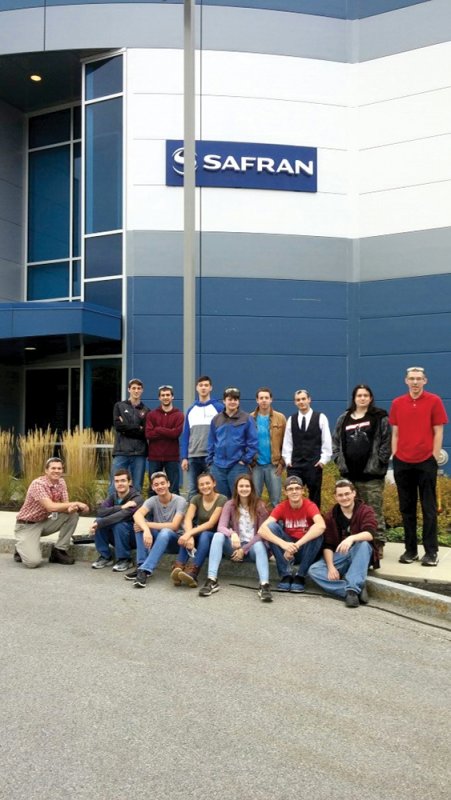
A group of students from Spaulding High School's Richard W. Creteau Tech Center at Safran in Rochester. Courtesy of Spaulding High School.
Honoring the Past
But it is not only business success that makes a community vital. “It’s ... also historic preservation and making sure we recognize and honor the unique characteristics of our downtown,” says Mills of Rochester Main Street. “We don’t want Rochester to be a cookie-cutter downtown. There are certain buildings in Rochester that are historic and beautiful.”
Chief among them, she says, is the Rochester Opera House, built in 1908, designed by George G. Adams, and thought to be the only remaining opera house in the world with a mechanism to raise the orchestra floor at an incline for amphitheater-style seating and level it for other activities.
After falling into disrepair, the building was closed in 1974, but after several renovation efforts, most notably after the 1996 election of Mayor Harvey Bernier Jr., the structure is fully restored and presents a slate of shows annually.
Likewise, the Georgian Revival Rochester Public Library, constructed in 1905, was restored in 1996 to include a three-story addition, four meeting rooms and other improvements. It is such architectural gems that give the downtown its character, many say. “It’s a true community, without some megalopolis or major city feel,” says John Marzinzik, president and CEO of Frisbie Memorial Hospital and the Greater Rochester Chamber of Commerce’s 2017 Business Leader of the Year. “It really has a small-town, welcoming feel.”
Restructuring the Fair
Another Rochester hallmark is the Rochester Fair, which started in 1874 and grew into a nine-day event featuring agricultural exhibits, rides, an extensive midway, harness racing and demolition derby. Run by the Rochester Agricultural and Mechanical Association (RAMA), the fair found itself saddled by debt last year. Given declining attendance, the RAMA board reluctantly cancelled the 2017 event.
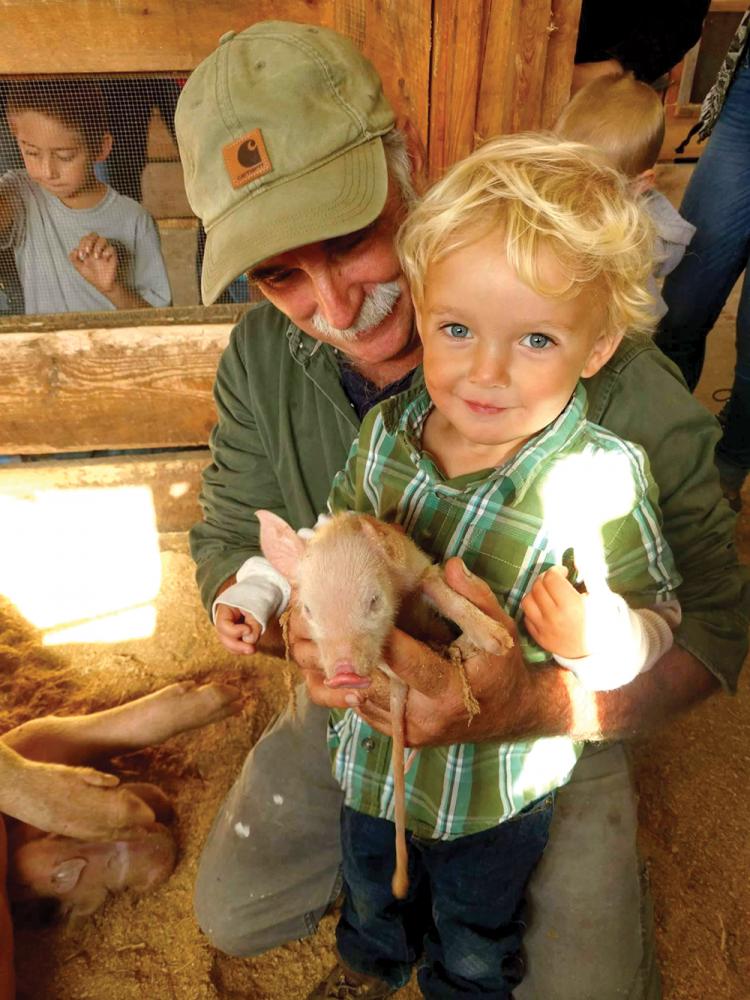
A child visits a piglet at the Rochester Fair. Courtesy photo.
Attempts to turn around the fair's fortunes continue but have hit rough patches. There’s been a restructuring of fair management and the mortgage on the property. Previously, the fair was run by a board, elected from RAMA shareholders. While the board hired an events manager instead of a general manager to get the fair back on track, the board recently confirmed its contract with its new events manager ended in February. Media reports indicate a rift in the vision for the direction of the fair between the events manager and some board members
and shareholders.
The events manager, Vickie Poland, wanted to have a “smaller, more agriculturally-based fair of four days” with “more emphasis on agriculture and livestock and community involvement.” However, others involved with the fair want an emphasis on the midway and racing. In February, the city struck a tentative deal to purchase 11 acres of the approximate 58-acre fair site for $450,000 to build a public works facility.
The fair is one of many cultural and recreational offerings. Rochester has a museum of fine arts, an annual Lilac Family Fun Festival in the spring, a summer festival at Rochester Commons, a July fourth event and a winter parade.
Jet Pack Comics in downtown Rochester takes part in the National Free Comic Book Day, held in May, organizing an event that involves several downtown merchants and attracts thousands of comic book fans to the city for the day.
And, the Rochester Pride event, held downtown in 2017 by the Rochester Museum of Fine Arts and Rochester Main Street to celebrate the LGBTQ community, attracted 3,000 visitors. Rochester is also home to the 18-hole Rochester Country Club, ball fields, hiking and walking paths, rivers and lakes.
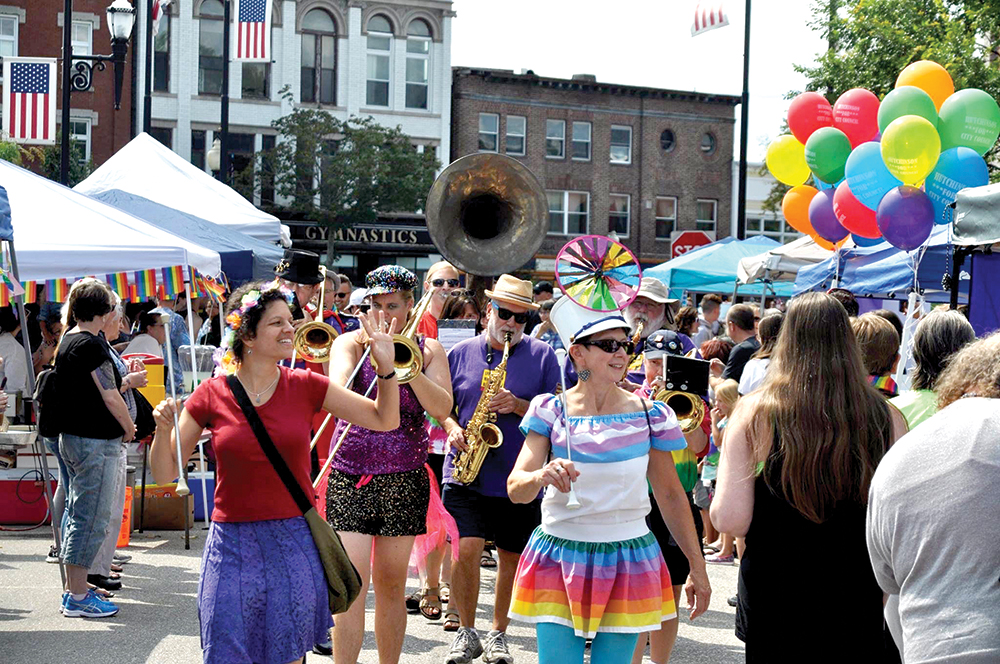
A Rochester Pride event. Courtesy of the Rochester Museum of Fine Arts.
Challenges and Opportunities
But with all of its successes, Rochester is still facing some challenges.
Chief among them is keeping momentum going downtown, which has seen ups and downs. City officials are working toward changes in density requirements that would allow for more residential use of upper floors in the downtown district. Because of factors like obsolete space and absentee owners, some properties in downtown are vacant or underutilized, according to Pollard’s report.
“We have created jobs over the years, but we have not created additional housing, so we have a shortage of housing for our workers,” she says.
The city’s approval this year of nearly 500 new housing units—many of them multi-family—will help, she adds, especially since research suggests prospective workers coming to the city are looking to rent rather than buy.
Likewise, the city wants to attract more millennials, who have now surpassed baby boomers and Gen Xers as the leading workforce category, according to a Pew Research Center study cited by Pollard. Details of those efforts were part of a strategic plan going before City Council in February.
Also in the planning stages is a Riverwalk that would follow the Cocheco River and connect the downtown with Route 11 and an abandoned rail line. Officials are updating an earlier Riverwalk plan, says Pollard, and an engineer has been hired to update pricing. “Potentially, we could connect it to Dover,” she says.
A beta “wayfinding” group has been established to address one of the longstanding complaints about Rochester’s downtown—how difficult it is to find one’s way around. Envisioned is a series of signs for pedestrians, bicyclists and motorists to help them find their way through the community. The design is nearly complete, and Pollard says funds will be requested in the upcoming budget year.
“In my view, what distinguishes Rochester is its heart, which can be found in its people,” says Laura Ring, president of the Greater Rochester Chamber of Commerce.
“For a downtown to thrive, you have to have people,” she adds. Mills, of Rochester Main Street, concurs. “We’re looking for people who haven’t experienced downtown Rochester, or who are only familiar with the Rochester of 30 years ago, to come downtown and see what Rochester’s about.”

 Current Issue - April 2024
Current Issue - April 2024